Posts
Comments
For clarity, at the moment of writing I felt that was a valid concern.
Currently I think this is no longer compelling to me personally, though I think at least some of our stakeholders would be concerned if we published work that significantly sped up AI capabilities and investment, which is a perspective we keep in mind when deciding what to work on.
I never thought that just because something speed up capabilities it means it is automatically something we shouldn't work on. We are willing to make trade offs here in service of our core mission of improving the public understanding of the trajectory of AI. And in general we make a strong presumption in favour of freedom of knowledge.
I'm talking from a personal perspective here as Epoch director.
- I personally take AI risks seriously, and I think they are worth investigating and preparing for.
- I co-started Epoch AI to get evidence and clarity on AI and its risks and this is still a large motivation for me.
- I have drifted towards a more skeptical position on risk in the last two years. This is due to a combination of seeing the societal reaction to AI, me participating in several risk evaluation processes, and AI unfolding more gradually than I expected 10 years ago.
- Currently I am more worried about concentration in AI development and how unimproved humans will retain wealth over the very long term than I am about a violent AI takeover.
- I also selfishly care about AI development happening fast enough that my parents, friends and myself could benefit from it, and I am willing to accept a certain but not unbounded amount of risk from speeding up development. Id currently be in favour of slightly faster development, specially if it could happen in a less distributed way. I feel very nervous about this however, as I see my beliefs as brittle.
I'm also going to risk also sharing more internal stuff without coordinating on it, erring on the side of over sharing. There is a chance that other management at Epoch won't endorse these takes.
- At management level, we are choosing to not talk about risks or work on risk measurement publicly. If I try to verbalize it, it's due to a combination of us having different beliefs on AI risk, which makes communicating from a consensus view difficult, believing that talking about risk would alienate us from stakeholders skeptical of AI Risk, and the evidence about risk being below what we are comfortable writing about.
- My sense is that OP is funding us primarily to gather evidence relevant to their personal models. Eg two senior people at OP particularly praised our algorithmic progress paper because it directly informs their models. They do also care about us producing legible evidence on key topics for policy, such as the software singularity or post training enhancements. We have had complete editorial control and I feel confident in rejecting topic suggestions that come from OP staff when they don't match my vision of what we should be writing about (and have done so in the past).
- In term of overall beliefs, we have a mixture of people very worried and skeptical of risk. I think the more charismatic and outspoken people at Epoch err towards being more skeptical of risks, but no one at Epoch is dismissive of it.
- Some stakeholders I've talked to have expressed this view that they wish for Epoch AI to gain influence and then communicate publicly about AI risk. I don't feel comfortable with that strategy, one should expect Epoch AI to keep a similar level of communication about risk as we gain influence. We might be willing to talk more about risks if we gather more evidence of risk, or if we build more sophisticated tools to talk about it, but this isn't the niche we are filling or that you should expect us to fill.
- The podcast is actually a good example here. We talk toward the end about the share of the economy owned by biological humans becoming smaller over time, which is an abstraction we have studied and have moderate confidence in. This is compatible with an AI takeover scenario, but also a peaceful transition to an AI dominated society. This is the kind of communication about risks you can expect from Epoch, relying more on abstractions we have studied than stories we don't have confidence in.
- The overall theory of change of Epoch AI is that having reliable evidence on AI will help raise the standards of conversation and decision making elsewhere. To be maximally clear, we are willing to make some tradeoffs like publishing work like FrontierMath and our distributed training paper that plausibly speed up AI development in service of that mission.
The ability to pay liability is important to factor in and this illustrates it well. For the largest prosaic catastrophes this might well be the dominant consideration
For smaller risks, I suspect in practice mitigation, transaction and prosecution costs are what dominates the calculus of who should bear the liability, both in AI and more generally.
What's the FATE community? Fair AI and Tech Ethics?
We have conveniently just updated our database if anyone wants to investigate this further!
https://epochai.org/data/notable-ai-models
Here is a "predictable surprise" I don't discussed often: given the advantages of scale and centralisation for training, it does not seem crazy to me that some major AI developers will be pooling resources in the future, and training jointly large AI systems.
I've been tempted to do this sometime, but I fear the prior is performing one very important role you are not making explicit: defining the universe of possible hypothesis you consider.
In turn, defining that universe of probabilities defines how bayesian updates look like. Here is a problem that arises when you ignore this: https://www.lesswrong.com/posts/R28ppqby8zftndDAM/a-bayesian-aggregation-paradox
shrug
I think this is true to an extent, but a more systematic analysis needs to back this up.
For instance, I recall quantization techniques working much better after a certain scale (though I can't seem to find the reference...). It also seems important to validate that techniques to increase performance apply at large scales. Finally, note that the frontier of scale is growing very fast, so even if these discoveries were done with relatively modest compute compared to the frontier, this is still a tremendous amount of compute!
even a pause which completely stops all new training runs beyond current size indefinitely would only ~double timelines at best, and probably less
I'd emphasize that we currently don't have a very clear sense of how algorithmic improvement happens, and it is likely mediated to some extent by large experiments, so I think is more likely to slow timelines more than this implies.
I agree! I'd be quite interested in looking at TAS data, for the reason you mentioned.
I think Tetlock and cia might have already done some related work?
Question decomposition is part of the superforecasting commandments, though I can't recall off the top of my head if they were RCT'd individually or just as a whole.
ETA: This is the relevant paper (h/t Misha Yagudin). It was not about the 10 commandments. Apparently those haven't been RCT'd at all?
We actually wrote a more up to date paper here
I cowrote a detailed response here
https://www.cser.ac.uk/news/response-superintelligence-contained/
Essentially, this type of reasoning proves too much, since it implies we cannot show any properties whatsoever of any program, which is clearly false.
Here is some data through Matthew Barnett and Jess Riedl
Number of cumulative miles driven by Cruise's autonomous cars is growing as an exponential at roughly 1 OOM per year.
That is to very basic approximation correct.
Davidson's takeoff model illustrates this point, where a "software singularity" happens for some parameter settings due to software not being restrained to the same degree by capital inputs.
I would point out however that our current understanding of how software progress happens is somewhat poor. Experimentation is definitely a big component of software progress, and it is often understated in LW.
More research on this soon!
algorithmic progress is currently outpacing compute growth by quite a bit
This is not right, at least in computer vision. They seem to be the same order of magnitude.
Physical compute has growth at 0.6 OOM/year and physical compute requirements have decreased at 0.1 to 1.0 OOM/year, see a summary here or a in depth investigation here
Another relevant quote
Algorithmic progress explains roughly 45% of performance improvements in image classification, and most of this occurs through improving compute-efficiency.
is not a transpose! It is the timestep . We are raising to the -th power.
Thanks!
Our current best guess is that this includes costs other than the amortized compute of the final training run.
If no extra information surfaces we will add a note clarifying this and/or adjust our estimate.
Thanks Neel!
The difference between tf16 and FP32 comes to a x15 factor IIRC. Though also ML developers seem to prioritise other characteristics than cost effectiveness when choosing GPUs like raw performance and interconnect, so you can't just multiply the top price performance we showcase by this factor and expect that to match the cost performance of the largest ML runs today.
More soon-ish.
Because there is more data available for FP32, so it's easier to study trends there.
We should release a piece soon about how the picture changes when you account for different number formats, plus considering that most runs happen with hardware that is not the most cost-efficient.
Note that Richard is not treating knightian uncertainty as special and unquantifiable, but instead is giving examples of how to treat it like any other uncertainty, that he is explicitly quantifying and incorporating in his predictions.
I'd prefer calling Richard's "model error" to separate the two, but I'm also okay appropriating the term as Richard did to point to something coherent.
To my knowledge, we currently don’t have a way of translating statements about “loss” into statements about “real-world capabilities”.
My intuition is that it's not a great approximation in those cases, similar to how in regular Laplace the empirical approximation is not great when you have eg N<5
Id need to run some calculations to confirm that intuition though.
Here is a 2012 meme about SolidGoldMagikarp
This site claims that the strong SolidGoldMagikarp was the username of a moderator involved somehow with Twitch Plays Pokémon
I still don't understand - did you mean "when T/t is close to zero"?
What's r?
That's exactly right, and I think the approximation holds as long as T/t>>1.
This is quite intuitive - as the amount of data goes to infinity, the rate of events should equal the number of events so far divided by the time passed.
If you want to join the Spanish-speaking EA community, you can do so through this link!
I agree with the sentiment that indiscriminate regulation is unlikely to have good effects.
I think the step that is missing is analysing the specific policies No-AI Art Activist are likely to advocate for, and whether it is a good idea to support it.
My current sense is that data helpful for alignment is unlikely to be public right now, and so harder copyright would not impede alignment efforts. The kind of data that I could see being useful are things like scores and direct feedback. Maybe at most things like Amazon reviews could end up being useful for toy settings.
Another aspect that the article does not touch on is that copyright enforcement could have an adverse effect. Currently there is basically no one trying to commercialize training dataset curation because enforcing copyright use is a nightmare. It is in fact a common good. I'd expect there would be more incentives to create large curated datasets if this was not the case.
Lastly, here are some examples of "no AI art" legislation I expect the movement is likely to support:
- Removing copyright protection of AI generated images
- Enforcing AI training data to be strictly opt-in
- Forcing AI content to be labelled as such
Besides regulation, I also expect activists to 4) pressure companies to deboost AI made content in social medial sites.
My general impression is that 3) is slightly good for AI safety. People in the AI Safety community have advocated for it in the past, convincingly.
I'm more agnostic on 1), 2) and 4).
1 and 4 will make AI generation less profitable, but also it's somewhat confused - it's a weird double standard to apply to AI content over human made content.
2 makes training more annoying, but could lead to commercialization of datasets and more collective effort being put into building them. I also think there is a possibly a coherent moral case for it, which I'm still trying to make my mind about, regardless of the AI safety consequences.
All in all, I am confused, though I wholeheartedly agree that we should be analysing and deciding to support specific policies rather than eg the anti AI art movement as a whole.
Great work!
Stuart Armstrong gave one more example of a heuristic argument based in the presumption of independence here.
Here are my quick takes from skimming the post.
In short, the arguments I think are best are A1, B4, C3, C4, C5, C8, C9 and D. I don't find any of them devastating.
A1. Different calls to ‘goal-directedness’ don’t necessarily mean the same concept
I am not sure I parse this one.I am reading it as "AI systems might be more like imitators than optimizers" from the example, which I find moderately persuasive
A2. Ambiguously strong forces for goal-directedness need to meet an ambiguously high bar to cause a risk
I am not sure I understand this one either.I am reading it as "there might be no incentive for generality" which I dont find persuasive - I think there is a strong incentive
B1. Small differences in utility functions may not be catastrophic
I dont find this persuasive. I think the evidence from optimization theory setting variables to extreme values is suggestive enough to suggest this is not the default
B2. Differences between AI and human values may be small
B3. Maybe value isn’t fragile
The only example we have of general intelligence (humans) seems to have strayed pretty far from evolutionary incentives, so I find this unpersuasive
B4. [AI might only care about]Short-term goals
I find that somewhat persuasive, or at least not obviously wrong, similar to A1. There is a huge incentive for instilling long term thinking though.
C1. Human success isn’t from individual intelligence
I dont find this persuasive. Im not convinced there is a meaningful difference between "a single AGI" and "a society of AGIs". A single AGI could be running a billion independent threads of thought and outspeed humans.
C2. AI agents may not be radically superior to combinations of humans and non-agentic machines
I dont find this persuasive. Seems unlikely that human-in-the-loop is going to have any advantages over pure machines.
C3. Trust
I find this plausible but not convincing
C4. Headroom
Plausible but not convincing. I dont find any of the particular examples of lack of headroom convincing, and I think the prior should be that there is a lot of headroom
C5. Intelligence may not be an overwhelming advantage
I find this moderately persuasive though not entirely convincing
C6. Unclear that many goals realistically incentivise taking over the universe
I find this unconvincing. I think there are many reasons to expect that taking over the universe is a convergent goal.
C7. Quantity of new cognitive labor is an empirical question, not addressed
I dont find this superpersuasive. In particular I think there is a good chance that once we have AGI we will be in a hardware overhang and be able to execute tons of AGI-equivalents
C8. Speed of intelligence growth is ambiguous
I find this plausible
C9. Key concepts are vague
Granted but not a refutation in itself
D1. The argument overall proves too much about corporations
I find this somewhat persuasive
Eight examples, no cherry-picking:
Nit: Having a wall of images makes this post unnecessarily harder to read.
I'd recommend making a 4x2 collage with the photos so they don't take that much space.
As it is often the case, I just found out that Jaynes was already discussing a similar issue to the paradox here in his seminal book.
I also found this thread of math topics on AI safety helpful.
Ah sorry for the lack of clarity - let's stick to my original submission for PVE
That would be:
[0,1,0,1,0,0,9,0,0,1,0,0]
Yes, I am looking at decks that appear in the dataset, and more particularly at decks that have faced a deck similar to the rival's.
Good to know that one gets similar results using the different scoring functions.
I guess that maybe the approach does not work that well ¯\_(ツ)_/¯
Thank you for bringing this up!
I think you might be right, since the deck is quite undiverse and according to the rest diversity is important. That being said, I could not find the mistake in the code at a glance :/
Do you have any opinions on [1, 1, 0, 1, 0, 1, 2, 1, 1, 3, 0, 1]? This would be the worst deck amongst the decks that played against a deck similar to the rival's in my code, according to my code.
Marius Hobbhahn has estimated the number of parameters here. His final estimate is 3.5e6 parameters.
Anson Ho has estimated the training compute (his reasoning at the end of this answer). His final estimate is 7.8e22 FLOPs.
Below I made a visualization of the parameters vs training compute of n=108 important ML system, so you can see how DeepMind's syste (labelled GOAT in the graph) compares to other systems.
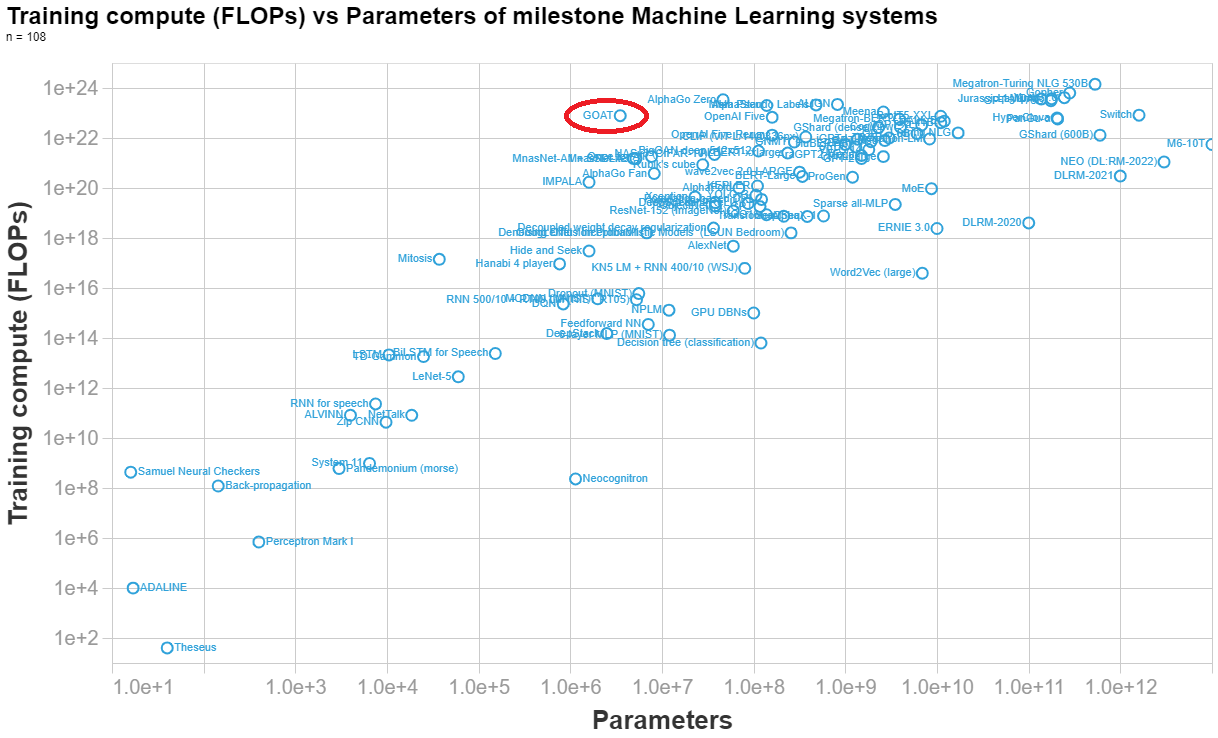
[Final calculation]
(8 TPUs)(4.20e14 FLOP/s)(0.1 utilisation rate)(32 agents)(7.3e6 s/agent) = 7.8e22 FLOPs==========================
NOTES BELOW[Hardware]
- "Each agent is trained using 8 TPUv3s and consumes approximately 50,000 agent steps (observations) per second."
- TPUv3 (half precision): 4.2e14 FLOP/s
- Number of TPUs: 8
- Utilisation rate: 0.1[Timesteps]
- Figure 16 shows steps per generation and agent. In total there are 1.5e10 + 4.0e10 + 2.5e10 + 1.1e11 + 2e11 = 3.9e11 steps per agent.
- 3.9e11 / 5e4 = 8e6 s → ~93 days
- 100 million steps is equivalent to 30 minutes of wall-clock time in our setup. (pg 29, fig 27)
- 1e8 steps → 0.5h
- 3.9e11 steps → 1950h → 7.0e6 s → ~82 days
- Both of these seem like overestimates, because:
“Finally, on the largest timescale (days), generational training iteratively improves population performance by bootstrapping off previous generations, whilst also iteratively updating the validation normalised percentile metric itself.” (pg 16)
- Suggests that the above is an overestimate of the number of days needed, else they would have said (months) or (weeks)?
- Final choice (guesstimate): 85 days = 7.3e6 s[Population size]
- 8 agents? (pg 21) → this is describing the case where they’re not using PBT, so ignore this number
- The original PBT paper uses 32 agents for one task https://arxiv.org/pdf/1711.09846.pdf (in general it uses between 10 and 80)
- (Guesstimate) Average population size: 32
Fixed, thanks!
Here is my very bad approach after spending ~one hour playing around with the data
- Filter decks that fought against a similar to the rivals deck, using a simple measure of distance (sum of absolute differences between the deck components)
- Compute a 'score' of the decks. The score is defined as the sum of 1/deck_distance(deck) * (1 or -1 depending on whether the deck won or lost against the challenger)
- Report the deck with the maximum score
So my submission would be: [0,1,0,1,0,0,9,0,0,1,0,0]
Seems like you want to include A, L, P, V, E in your decks, and avoid B, S, K. Here is the correlation between the quantity of each card and whether the deck won. The ordering is ~similar when computing the inclusion winrate for each card.
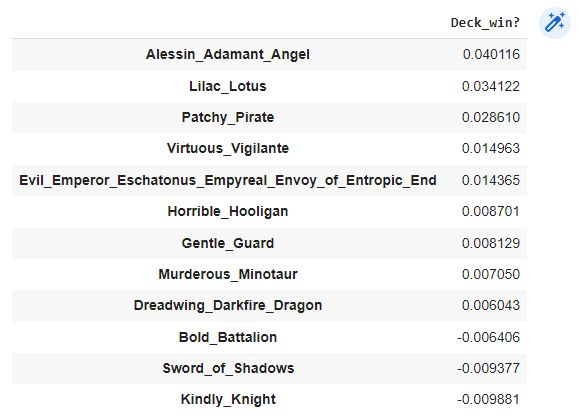
Thanks for the comment!
I am personally sympathetic to the view that AlphaGo Master and AlphaGo Zero are off-trend.
In the regression with all models the inclusion does not change the median slope, but drastically increases noise, as you can see for yourself in the visualization selecting the option 'big_alphago_action = remove' (see table below for a comparison of regressing the large model trend without vs with the big AlphaGo models).

In appendix B we study the effects of removing AlphaGo Zero and AlphaGo Master when studying record-setting models. The upper bound of the slope is affected dramatically, and the R2 fit is much better when we exclude them, see table 6 reproduced below.
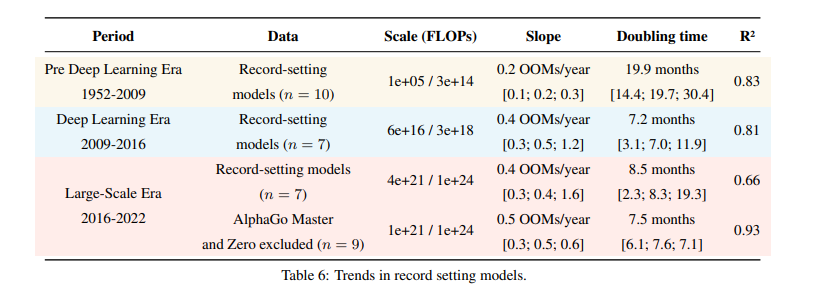
Following up on this: we have updated appendix F of our paper with an analysis of different choices of the threshold that separates large-scale and regular-scale systems. Results are similar independently of the threshold choice.
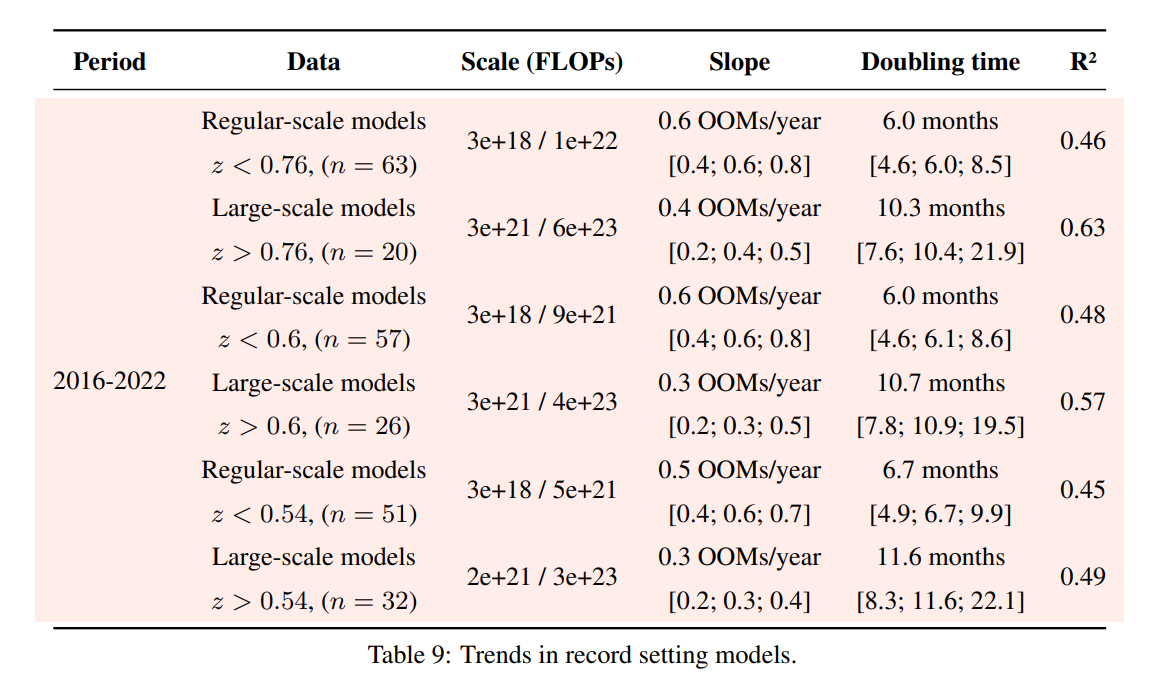
Thanks for engaging!
To use this theorem, you need both an (your data / evidence), and a (your parameter).
Parameters are abstractions we use to simplify modelling. What we actually care about is the probability of unkown events given past observations.
You start out discussing what appears to be a combination of two forecasts
To clarify: this is not what I wanted to discuss. The expert is reporting how you should update your priors given the evidence, and remaining agnostic on what the priors should be.
A likelihood isn't just something you multiply with your prior, it is a conditional pmf or pdf with a different outcome than your prior.
The whole point of Bayesianism is that it offer a precise, quantitative answer to how you should update your priors given some evidence - and that is multiplying by the likelihoods.
This is why it is often recommend in social sciences and elsewhere to report your likelihoods.
I'm not sure we ever observe [the evidence vector] directly
I agree this is not common in judgemental forecasting, where the whole updating process is very illegible. I think it holds for most Bayesian-leaning scientific reporting.
it is pretty clear from your post that you're talking about in the sense used above, not .
I am not, I am talking about evidence = likelihood vectors.
One way to think about this is that the expert is just informing us about how we should update our beliefs. "Given that the pandemic broke out in Wuhan, your subjective probability of a lab break should increase and it should increase by this amount". But the final probability depends on your prior beliefs, that the expert cannot possibly know.
I don't think there is a unique way to go from to, let's say, , where is the expert's probability vector over and your probability vector over .
Yes! If I am understanding this right, I think this gets to the crux of the post. The compression is lossy, and neccessarily loses some information.
Great sequence - it is a nice compendium of the theories and important thought experiments.
I will probably use this as a reference in the future, and refer other people here for an introduction.
Looking forward to future entries!
I am glad Yair! Thanks for giving it a go :)
Those I know who train large models seem to be very confident we will get 100 Trillion parameter models before the end of the decade, but do not seem to think it will happen, say, in the next 2 years.
FWIW if the current trend continues we will first see 1e14 parameter models in 2 to 4 years from now.
I am pretty pumped about this. Google docs + latex support is huge game for me.
There's also a lot of research that didn't make your analysis, including work explicitly geared towards smaller models. What exclusion criteria did you use? I feel like if I was to perform the same analysis with a slightly different sample of papers I could come to wildly divergent conclusions.
It is not feasible to do an exhaustive analysis of all milestone models. We necessarily are missing some important ones, either because we are not aware of them, because they did not provide enough information to deduce the training compute or because we haven't gotten to annotate them yet.
Our criteria for inclusion is outlined in appendix A. Essentially it boils down to ML models that have been cited >1000 times, models that have some historical significance and models that have been deployed in an important context (eg something that was deployed as part of Bing search engine would count). For models in the last two years we were more subjective, since there hasn't been enough time for the more relevant work to stand out the test of time.
We also excluded 5 models that have abnormally low compute, see figure 4.
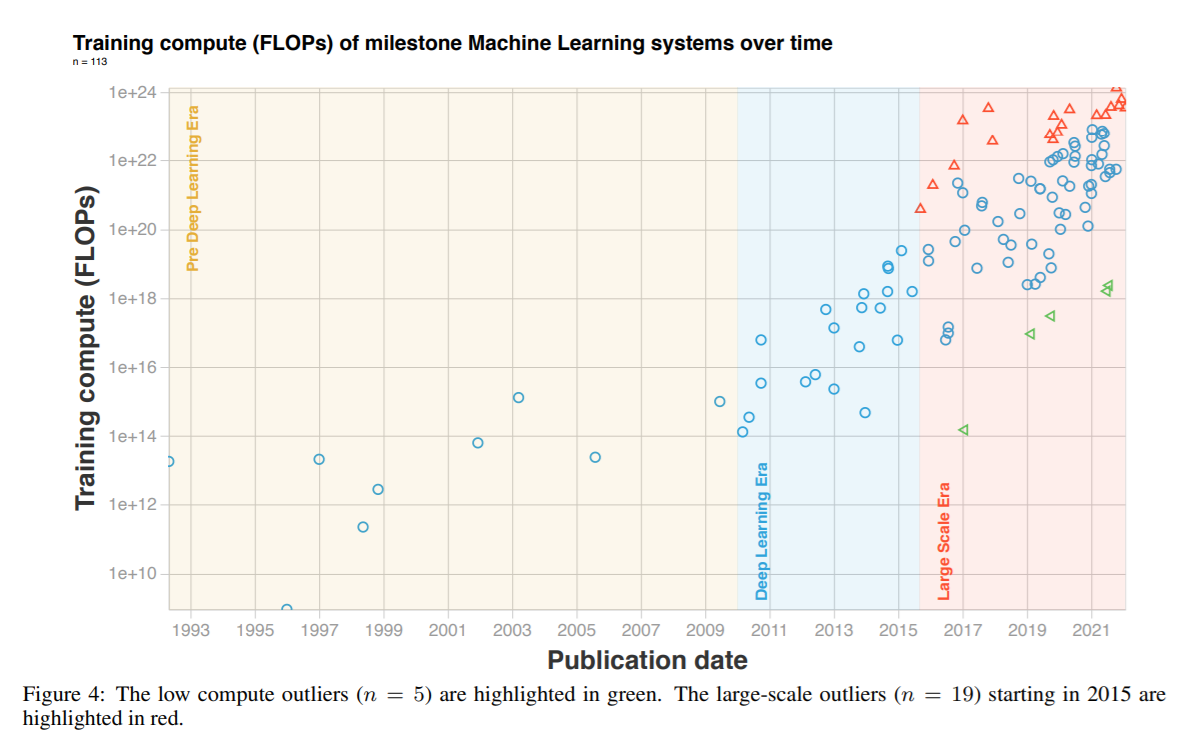
We tried playing around with the selection of papers that was excluded and it didn't significantly change our conclusions, though obviously the dataset is biased in many ways. Appendix G discusses the possible biases that may have crept in.